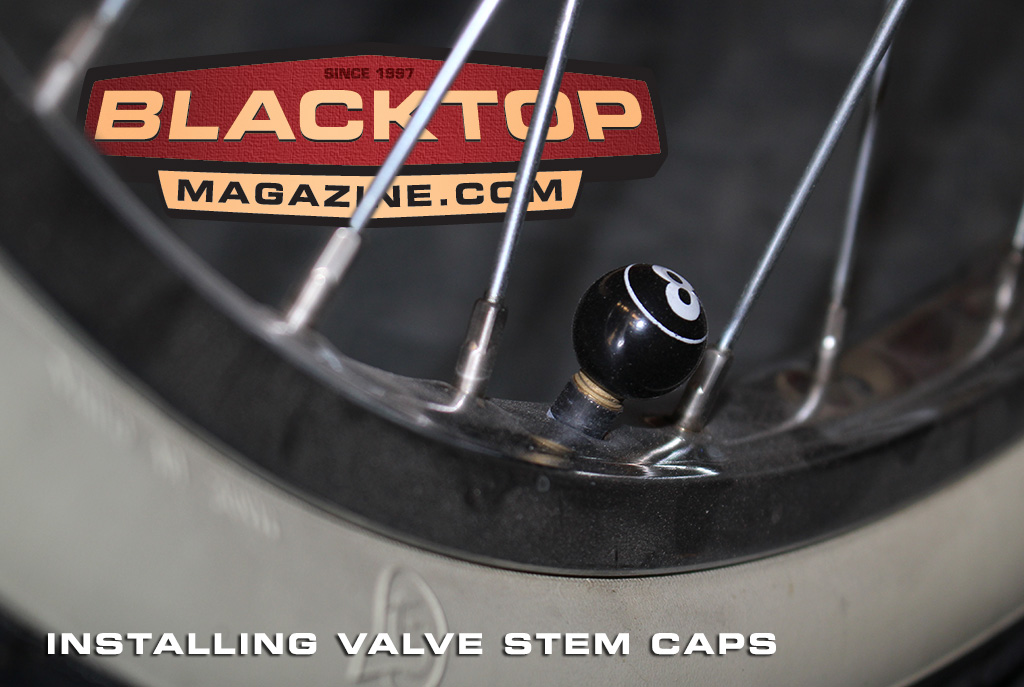A Blacktop Magazine Professional Tech Article

Bench Racing with T-Bone
Blacktop Magazine’s, Shocker Choppers Garage is a professional place and here in California, we have to abide by every insane rule that may disrupt a tiny species that nobody really cares about.
Here is the first in our series of professional tech articles on how we work within the strict guidelines of governmental intervention. Today’s topic:
Installing or replacing valve stem caps on almost any wheel, tire or tube.
Items needed.
- Wheel and tire assembly, which uses air to pressurize. That’s right – all you old dudes – no solid core tires for this demonstration. Preferred if the tire/tube is fully pressurized with air. If not, you will need to reverse the instructions below and refer to safety and maintenance chart 235-772-B, paragraph 8 sub-section A, line 5 for instructions on pressurizing your toroid shaped inflatable object.
- A pair of digits. Such as a small limb or organ for manipulation and sensation. Opposable thumbs are an advantage and some of you may in-fact have such a device on you at this very moment.
- Valve Stem Cap. A cylindrical apparatus that is threaded on the inside to match the standardized threads of a valve stem as part of the first item, the wheel and tire assembly.
Before we get into the meat of the issue it is important to first discover why a valve stem cap, or VSC to those in the know, is needed. Contrary to local folklore, the VSC is not required to be air-tight. The VSC is not required to inhibit pressurized air to escape from the toroid object.
Here are a couple of reasons deducted from years of scientific research funded by incredibly wealthy and incompetent boobs on why a VSC is really necessary:
- To protect the valve stem from collecting debris and gunk and thus inhibiting the facilitation of increasing air pressure to the toroid.
- Create a statement of camaraderie with ornamental disfiguration of the cylindrical VSC. Such is the example seen here with the 8-ball design.
- To communicate the contents of the toroid. In recent years scientists have discovered that the molecular weight of nitrogen is slightly smaller than that of air. Oxygen with its weak dipole interaction between molecules allow it to escape in smaller pores and thus lose it’s pressure quicker than that of nitrogen. Also they can charge up to $10.00 more per tire to fill it with nitrogen and then install a GREEN VSC.
Now for the Instructions:
(Please note that failure to follow each rule may result in injury or death)
- Inspect the wheel and tire assembly.
- Locate the valve stem, the cylindrical device protruding inward from the inside of the toroid shape.
- Grasp Valve Stem Cap with two digits.
- Align the opening of the VSC to the tip of the valve stem.
- Twist in a clock-wise fashion the VSC onto the tip of the valve stem.
- Feel for an easy turn. If not found twist backward a half rotation to find the matching threads of each device.
- When properly met, twist the VSC completely down the shaft of the valve stem.
- Do not over-tighten.
- Step back and inspect.
- Does the VSC appear to be securely?
- If Yes. You are complete. Thank you for your patience now enjoy your new-found knowledge and share it with a friend.
- If No. Twist the VSC in a counter-clockwise fashion until it is completely free of the valve stem and start over with step 4.
Shocker Choppers is committed to your safety and security while you are working in the shop. If you have a technical challenged you’d like to solve, please don’t hesitate to call.






